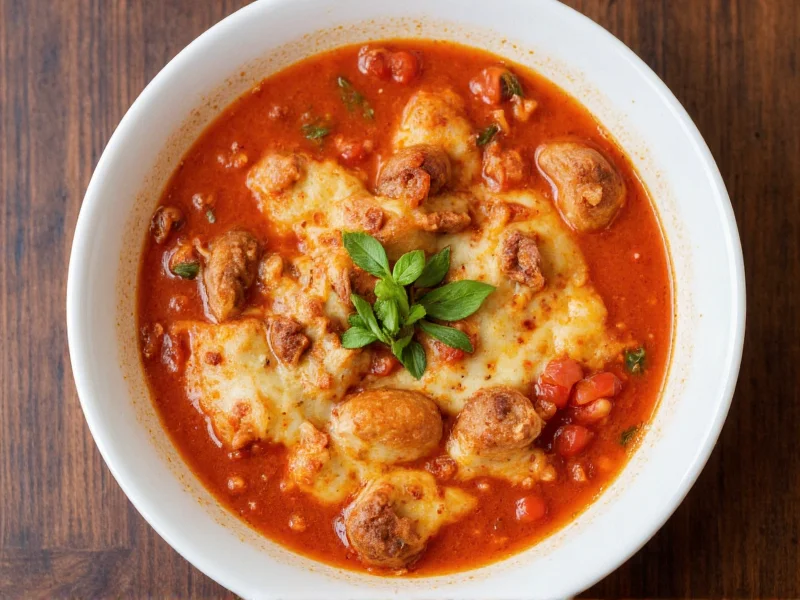Pizza soup transforms your favorite pizza flavors into a satisfying bowl of comfort. Unlike traditional soups, this recipe intentionally mimics the layered taste profile of pizza through carefully balanced ingredients and preparation techniques. The magic happens when tomato base, melted cheese, and pizza toppings unite in perfect harmony.
The Essential Pizza Soup Components
Creating authentic pizza soup requires understanding its foundational elements. Each component serves a specific purpose in replicating that beloved pizza experience:
| Component | Function | Key Ingredients |
|---|---|---|
| Broth Base | Provides pizza sauce flavor foundation | Tomato puree, crushed tomatoes, Italian herbs |
| Cheese Element | Recreates melted cheese experience | Mozzarella, provolone, Parmesan |
| Toppings | Delivers signature pizza toppings experience | Pepperoni, sausage, mushrooms, olives |
| Texture Component | Mimics pizza crust satisfaction | Croutons, bread chunks, or pasta |
Step-by-Step Preparation Guide
Follow these professional techniques to achieve restaurant-quality pizza soup at home. The key to perfect pizza soup lies in layering flavors properly and maintaining the right consistency.
Building Flavor Foundations
Start by sautéing onions, garlic, and your choice of meat (like Italian sausage) until properly browned. This creates the flavor base that distinguishes homemade pizza soup from ordinary tomato soup. Add tomato products gradually, allowing each addition to reduce slightly before adding more. This technique concentrates flavors and prevents watery soup.
Cheese Integration Technique
The cheese element requires special attention. Rather than adding cheese directly to boiling soup (which causes separation), create a roux with butter and flour first, then gradually whisk in milk or cream before adding shredded cheese. This emulsification process ensures smooth, creamy texture without clumping—a critical step in any homemade pizza soup recipe aiming for professional results.
Popular Pizza Soup Variations
Adapt this versatile recipe to accommodate different dietary preferences while maintaining authentic pizza flavor:
- Meat Lovers Version: Combine Italian sausage, pepperoni, and bacon for maximum meaty goodness
- Vegetarian Option: Use plant-based sausage and load up on mushrooms, bell peppers, and olives
- Gluten-Free Adaptation: Substitute regular pasta with gluten-free alternatives and use cornstarch instead of flour for thickening
- Creamy White Pizza Soup: Replace tomato base with Alfredo sauce for a white pizza interpretation
Avoiding Common Pizza Soup Mistakes
Even experienced cooks make these critical errors when preparing pizza soup:
- Adding cheese to boiling liquid - Always remove soup from heat before incorporating cheese to prevent separation
- Overcooking toppings - Add delicate toppings like fresh basil or pre-cooked pepperoni near the end
- Using low-quality broth - The broth forms the flavor foundation; never compromise here
- Skipping the resting period - Allow soup to rest for 15 minutes before serving for flavors to meld
Serving Suggestions for Maximum Enjoyment
Elevate your pizza soup from scratch experience with these professional presentation tips:
Serve in pre-warmed bowls to maintain optimal temperature. Top with freshly grated Parmesan, a sprinkle of red pepper flakes, and a drizzle of high-quality olive oil. For the complete pizza experience, accompany with garlic bread or a small side salad. Consider offering different topping stations so guests can customize their bowls with additional pepperoni, extra cheese, or fresh basil.
Storage and Reheating Best Practices
Proper storage ensures your pizza soup maintains quality when enjoyed later. Cool soup completely before transferring to airtight containers. Refrigerate for up to 4 days or freeze for up to 3 months.
When reheating, add a splash of broth or water to restore proper consistency, as the soup thickens when stored. Gently warm over medium-low heat while stirring frequently. If the soup contains dairy, avoid boiling which can cause separation. For frozen soup, thaw overnight in the refrigerator before reheating.
Perfecting Your Pizza Soup Technique
Mastering authentic pizza flavor in soup form requires attention to detail at every stage. The most successful pizza soups balance acidity from tomatoes with richness from cheese, while maintaining distinct pizza topping flavors. Experiment with different cheese blends—mozzarella provides that signature stretch, provolone adds depth, and Parmesan delivers umami richness.
Consider making your pizza soup in stages: prepare the base one day, then finish with cheese and toppings the next. This approach allows flavors to develop fully while preventing cheese from breaking down during storage. Remember that the best pizza soup variations for dietary needs maintain the core pizza flavor profile while accommodating restrictions.
Frequently Asked Questions
What makes pizza soup different from regular tomato soup?
Pizza soup specifically replicates the complete pizza flavor profile through strategic combination of tomato base, melted cheese elements, authentic pizza toppings, and texture components that mimic crust. Regular tomato soup lacks these intentional pizza flavor recreations and typically has simpler seasoning.
Can I make pizza soup without meat?
Absolutely. Vegetarian pizza soup works beautifully by using plant-based proteins like mushrooms, bell peppers, olives, and artichokes. For umami depth, add a splash of soy sauce or nutritional yeast to compensate for the absence of meat flavors.
Why does my pizza soup become grainy when I add cheese?
Cheese becomes grainy when added directly to boiling liquid. To prevent this, remove the soup from heat before adding cheese, and incorporate it gradually while stirring constantly. Creating a cheese sauce with a roux first ensures smooth integration and prevents separation.
How can I make pizza soup thicker without adding more pasta?
For thicker pizza soup without additional pasta, try blending a portion of the soup and returning it to the pot, using a cornstarch slurry, or adding a small amount of cream cheese. These methods maintain the intended pasta-to-soup ratio while achieving desired consistency.











 浙公网安备
33010002000092号
浙公网安备
33010002000092号 浙B2-20120091-4
浙B2-20120091-4